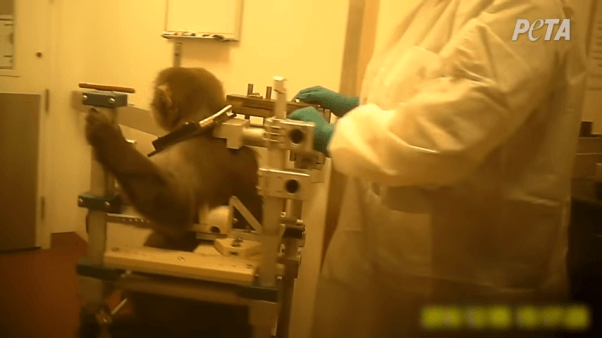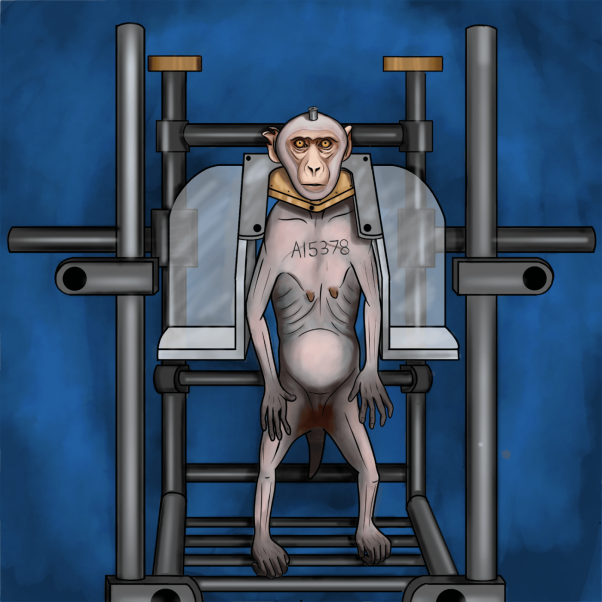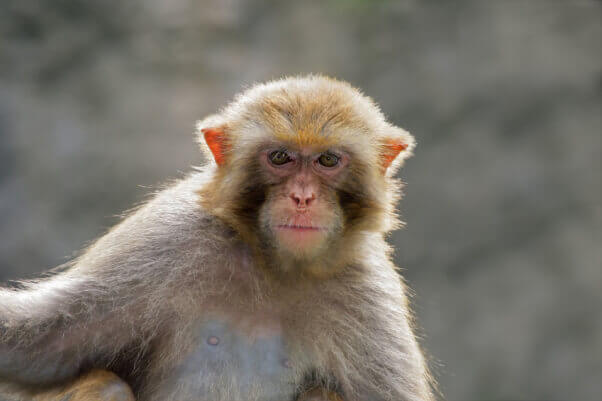Who Is Dorothy? Meet a Monkey Used for Breeding and Experiments
Dorothy was a rhesus macaque born on April 1, 1993, at a Texas laboratory, where she was kept in a pen with other monkeys and eventually used as a breeding machine. There, over the course of 20 years, she gave birth to 13 babies, all of whom were taken from her. By December 2015, she was clearly geriatric but was still considered useful to laboratories, because she hadn’t been subjected to any invasive surgeries or used in any experiments. So she was sold to the University of Washington’s Washington National Primate Research Center (WaNPRC), where she was renamed A15378. At the WaNPRC, when she was 22 years old, she was confined alone to a small metal cage for the first time in her life. She was assigned to experimenter Elizabeth Buffalo’s study, purportedly on the neurobiology of human aging.
During the next 2.5 years at the WaNPRC—the final years of her life—Dorothy never had a fellow monkey companion. Humans exploited her until her final days, when her frail, diseased body had withered and collapsed under the pressure of unrelenting experimentation and she was euthanized.
Dorothy was capable of love, joy, happiness, and affection. But to experimenters like those in Buffalo’s lab at WaNPRC, she was only a tool whose needs and emotions didn’t matter. As is the case with millions of other animals used in experiments every year, once she was of no more use to her captors, she was simply killed, discarded, and replaced.
Immobilized in a Chair: Here’s What Dorothy Endured in Experiments at WaNPRC
The first thing Buffalo did to Dorothy was put a bulky metal collar around her neck, which laboratory staff referred to mockingly as her “jewelry.” Then, experimenters began to withhold food and water from her when she was locked in what was referred to as her “home cage.”
Each day, lab staffers would reach into Dorothy’s cage with a long metal pole and use it to grab her by the collar. She was then taken to another room and locked, upright, into a “restraint chair” for several hours to begin her “training.”

An image of another monkey locked in a restraint chair.
Dorothy was kept immobile for hours in this grossly unnatural position, and she was only offered food or water when she correctly performed certain memory tasks. She was expected to “acclimate” to being hungry and held by her neck in this chair. She never did.
Staff reported that 40% of the time, she was unmotivated and failed to perform her tasks to the level that would ensure that she had adequate nutrition. Dorothy was doing everything in her power to let people know that her spirit and her body were crumbling. They weren’t listening.
In late 2017, experimenters made an incision in Dorothy’s head, drilled a hole in her skull, and surgically implanted and cemented a titanium post. It hadn’t been enough to restrain her by the neck for hours—now, they could control her even more by plugging her directly into the testing apparatus for hours a day. Another elderly monkey at the WaNPRC died 12 days after undergoing the same gruesome surgery.

WaNPRC Staff Ignored Dorothy’s Slow, Painful Decline
Dorothy was already a thin monkey when she arrived at the WaNPRC, but by late 2017, she was steadily losing weight. Her appetite was poor, she was anemic, and she had long ago pulled out all of her hair—a sign of extreme anxiety. She suffered from decreased range of motion in her hips, and she was constipated, her stomach often distended. By late March 2018, she had lost more than 20% of her body weight.
Isolated, elderly, hairless, and “underperforming,” Dorothy so obviously needed to be removed from the tortuous protocol that a member of the University of Washington’s oversight body—the Institutional Animal Care & Use Committee (IACUC)—raised detailed concerns about her continued use. But these concerns were dismissed.
According to food restriction guidelines for primates used in biomedical experimentation provided by the Association of Primate Veterinarians, Dorothy’s weight loss alone was reason enough to remove her from “food restriction motivational regimes” such as the one she was on.
But no.
Records show that the head of the IACUC and the director of the Office of Animal Welfare (who at the time was also the WaNPRC’s associate director) met privately with Buffalo, apparently to keep concerns from reaching other members of IACUC.
A month later, staff found Dorothy slumped over in her cage, bloated and not eating.
No matter. Her training regime continued unabated.
Buffalo’s laboratory claimed that Dorothy was merely constipated, and it refused to stop the daily torture, which went on for another month.
On May 8, 2018, a WaNPRC veterinarian euthanized Dorothy. Shortly after, her body was cut apart and examined.
What Did Experimenters Learn From Tormenting Dorothy? Nothing About Human Health
A study of Dorothy’s body after death revealed that her liver was failing and that she had cancer. Her body attacked her from the inside while experimenters waged daily attacks on her from the outside.The WaNPRC willfully exempted themselves from rules to continue Dorothy’s torture, despite her deteriorating health.
As is the case with the overwhelming majority of experiments on animals, any results gleaned from the painful tests that Dorothy was forced to endure offer no hope of curing—or even treating—naturally occurring diseases in humans. At most, her torment offered experimenters a few data points regarding the neurobiology of profound despair in a depressed monkey kept in solitary confinement during the last years of her tortured life. Her suffering—like the suffering of all other animals subjected to painful and cruel laboratory tests—was pointless.

It’s speciesist to believe that animals are test tubes or pincushions for humans to use. Animals like Dorothy have their own unique personalities and needs. They lead complex lives with desires and interests that are wholly separate from whatever twisted purpose humans might squeeze out of them through brute force. That’s just one of the many reasons why PETA provides the public and government leaders with information about superior, modern, humane, non-animal testing methods.
Take Action for Monkeys Used in Experiments
It’s too late for Dorothy, but you can help monkeys like her. Join PETA in urging the University of Washington to close down the WaNPRC and transfer the animals to reputable sanctuaries, where they can get the proper rest and care that they’ve so long been denied.

